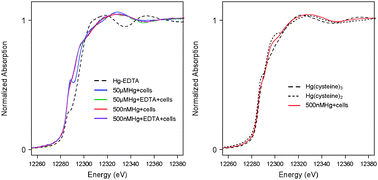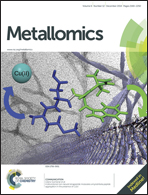Hg(ii) bacterial biouptake: the role of anthropogenic and biogenic ligands present in solution and spectroscopic evidence of ligand exchange reactions at the cell surface†
Abstract
We have used a whole cell biosensor to investigate how the chemical speciation of aqueous Hg(II) affects its biouptake. The reporter system consists of a model gram-negative bacterium (Escherichia coli) with a chromosomally inserted merR::luxCDABE fusion. Synthetic aminopolycarboxylate organic ligands (EDTA, DTPA, EDDS, and NTA) as well as naturally-occurring thiol-containing ligands (cysteine, penicillamine, and glutathione) were used to control Hg(II) speciation in solution. We observed that all aminopolycarboxylate ligands promote the biouptake of Hg(II), following trends unexplained by Hg(II) speciation. Hg(II) biouptake was greatly enhanced in the presence of cysteine whereas it was inhibited in the presence of penicillamine and glutathione. Bioreporter exposure to increasing concentrations of Hg(II) quantitatively complexed by EDTA, DTPA, EDDS and cysteine showed that the extent of uptake is dose-dependent until a plateau is reached. Additionally, Hg LIII-edge X-ray absorption near edge structure (XANES) spectra of Hg(II) associated with the bioreporter membrane under the conditions used to perform the biouptake experiments suggest that a ligand exchange reaction occurs between the Hg(II)–aminopolycarboxylate complex and thiol moieties at the cell membrane. We conclude that ligand-exchange reactions at the cell surface play a critical role in the bacterial biouptake of Hg(II).


 Please wait while we load your content...
Please wait while we load your content...